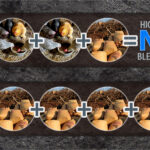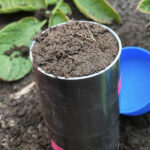
Sally Brown
BioCycle January 2016
I remember the first time I saw bolted lettuce in the field. I had a locally grown wholesale vegetable business called Long Island Produce (because I got all of my produce from farmers on Long Island, New York). It was long before I had even thought about graduate school or compost or biosolids — and long before the whole notion of local food systems had come into everyday parlance. I was picking up an order from a farmer for that morning’s deliveries. We found Fred (the farmer) in a field of lettuce. Scattered across the field were red leaf “Christmas trees” — aka lettuce past its prime. When the soil gets too hot or the lettuce gets too old, it bolts. Bolted lettuce develops a thick center stem or stalk and starts to grow tall. Bolted lettuce does bear some resemblance to Christmas trees. The leaves on the lettuce get very bitter and even those that love radicchio would not want those leaves anywhere near a salad. The lettuce trees looked pretty but I remember being upset at the waste they represented.
A lot has changed in the 30 years since, both for me personally and for our understanding of food systems and food waste. Growing food, as with almost everything else, does involve some level of waste. Nothing is 100 percent efficient. The questions are how to minimize that waste and how to bring some value to the food that does not meet optimal standards so that it does not become waste. This question can be considered on a number of levels.
Much of our lettuce is grown in California. The reason so much of what we eat is grown in California has to do with the state’s ideal growing climate for much of the year. While lettuce can be grown easily in other parts of the country during select times of the year, it is generally much easier and more efficient to grow lettuce from November to March in California than in Chicago. The relatively stable climate also reduces the chances that the lettuce will suddenly be infused with the holiday spirit and bolt. However, not every head of lettuce will grow perfectly into what your normal supermarket wants or what your typical customer will buy. What is the best fate for this not quite ready for top shelf lettuce?
The best option is to have it eaten. Growing that head of lettuce requires a lot of water, energy to pump the water, and fertilizer. In fact, about 70 percent of the water used in California is used to grow crops. Not eating those crops is equivalent to wasting a lot of water (see “California Almonds,” June 2015). That lettuce also contains nutrients and calories — things that people who are food insecure need. Lettuce though, is not the food of choice for staving off hunger as it is primarily water and has very few calories or nutritional value. (The bolted lettuce “trees” just make for a fun post-holiday example!)
For the sake of simplicity, let’s just say that this is a unique variety of lettuce that contains a lot of nutrients and calories. The best and highest level consumer for this lettuce is a person. People are the most particular of all of the potential consumers and our appetites are far from satisfied. In fact, the challenge of feeding the additional two billion of us anticipated in the next few decades is one of the greatest challenges we face. For the grower and food distributor, this involves identifying a retail market for imperfect produce. Imperfect produce markets are starting to show up, e.g., Imperfect Produce in Emeryville, California. France just had a big campaign about eating ugly fruits and vegetables. I’ll get to the potential for other ways to get the lettuce to people in the sequel to this column in February BioCycle.
Pigs And Soil
Assuming that people aren’t an option, the next level of consumers are pigs. Pigs or other animals are not as picky as people, and likely can’t distinguish between romaine and red leaf. Animals are very energy intensive to raise and if we want to continue to eat them, using excess or imperfect people food to feed them is the next highest option on the ladder. In the last 50 years we (on a world wide basis) are eating 2.5 to 4.5 times more pork. A diet that includes pork has about triple the carbon intensity of a vegetarian based diet. Using human wasted food for animal food can reduce the quantity of land needed to grow food exclusively for animals. It also reduces the carbon intensity associated with barbecue and bacon. This is just one of the mitigation options recommended by the International Panel on Climate Change. It turns out that in many areas, food waste is being fed to pigs. Las Vegas is just one example of hogs getting the leftovers. Cairo is another.
It is only after the people and after the pigs that feeding the soil should come into consideration. The microbes that devour the organic matter in soil systems are even less picky than the pigs. For the stuff that can’t get to the people or the pigs, composting is a great option. Actually anaerobic digestion prior to composting is an even better option but here I am focusing on the food aspects. Letting the bugs in the compost pile eat the material reduces the volume that has to be transported back to the farm.
If no people or pigs can be found near the farm, then tilling crop waste into the soil can be a fine option. This is the lowest value for the food as there are other ways to enrich the soil. Companion planting, planting crops that fix nutrients to till back into the soil, planting crops that use less water or generate higher biomass are all more efficient ways to enrich soils. So are the wastes that people and pigs produce after eating the lettuce.
All of these practices make more sense than wasting food that could
be satisfying appetites well up the food chain.
Sally Brown is a Research Associate Professor at the University of Washington in Seattle and a member of BioCycle’s Editorial Board.









